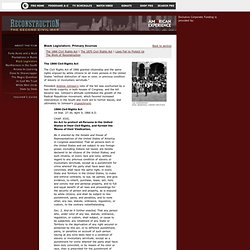

<i>The Doom of Reconstruction: The Liberal Republicans in the Civil War Era</i>. Find using OpenURL The Doom of Reconstruction: The Liberal Republicans in the Civil War Era (review) In lieu of an abstract, here is a brief excerpt of the content: This study of the liberal republican movement provides a sympathetic treatment of a small group of Republicans who were the founders of a challenge to the Republican party and the Ulysses S.

Grant administration during the election of 1872. The author specifically identifies twenty-three individuals he regards as core members of this group. This group only reluctantly supported many of the Union government war policies, which expanded and centralized federal power and threatened their long-standing faith in limited government and "classical republicanism" (210). The liberal republican movement, according to this study, originated in Missouri and soon recruited prominent Republicans in the East who shared similar values.
Reconstruction - American Civil War. Ku Klux Klan - Facts & Summary. In 1915, white Protestant nativists organized a revival of the Ku Klux Klan near Atlanta, Georgia, inspired by their romantic view of the Old South as well as Thomas Dixon’s 1905 book “The Clansman” and D.W.

Griffith’s 1915 film “Birth of a Nation.” This second generation of the Klan was not only anti-black but also took a stand against Roman Catholics, Jews, foreigners and organized labor. It was fueled by growing hostility to the surge in immigration that America experienced in the early 20th century along with fears of communist revolution akin to the Bolshevik triumph in Russia in 1917.
The organization took as its symbol a burning cross and held rallies, parades and marches around the country. At its peak in the 1920s, Klan membership exceeded 4 million people nationwide. Ku Klux Klan in the Reconstruction Era. Reconstruction: The Second Civil War. The Civil Rights Act of 1866 granted citizenship and the same rights enjoyed by white citizens to all male persons in the United States "without distinction of race or color, or previous condition of slavery or involuntary servitude.

" President Andrew Johnson's veto of the bill was overturned by a two-thirds majority in both houses of Congress, and the bill became law. Johnson's attitude contributed the growth of the Radical Republican movement, which favored increased intervention in the South and more aid to former slaves, and ultimately to Johnson's impeachment. 1866 Civil Rights Act 14 Stat. 27-30, April 9, 1866 A.D. CHAP. 14th Amendment. Amendment XIV Section 1.

All persons born or naturalized in the United States, and subject to the jurisdiction thereof, are citizens of the United States and of the state wherein they reside. No state shall make or enforce any law which shall abridge the privileges or immunities of citizens of the United States; nor shall any state deprive any person of life, liberty, or property, without due process of law; nor deny to any person within its jurisdiction the equal protection of the laws.
Section 2. Representatives shall be apportioned among the several states according to their respective numbers, counting the whole number of persons in each state, excluding Indians not taxed. Section 3. Section 4. 14th Amendment to the U.S. Constitution: Primary Documents of American History (Virtual Programs & Services, Library of Congress) 15th Amendment to the Constitution: Primary Documents of American History (Virtual Programs & Services, Library of Congress) Fifteenth Amendment - Black History. Carpetbaggers & Scalawags - American Civil War. In general, the term “carpetbagger” refers to a traveler who arrives in a new region with only a satchel (or carpetbag) of possessions, and who attempts to profit from or gain control over his new surroundings, often against the will or consent of the original inhabitants.

After 1865, a number of northerners moved to the South to purchase land, lease plantations or partner with down-and-out planters in the hopes of making money from cotton. At first they were welcomed, as southerners saw the need for northern capital and investment to get the devastated region back on its feet. They later became an object of much scorn, as many southerners saw them as low-class and opportunistic newcomers seeking to get rich on their misfortune. Sharecropping - Black History.
TENANT FARMING AND SHARECROPPING. Sharecropping and tenant farming. Sharecropping was common throughout the South well into the twentieth century, and required the work of entire families.

In this famous photograph, a six year-old girl picks cotton in Oklahoma. (Photograph by Lewis W. Hine. Liberal Republicans—They're Alive! Until not long ago, we tended to think of Republicans as unified and focused, and Democrats as inherently fractious (see, for instance, the evergreen "Dems In Disarray" headline).

These days the opposite is true—or at least it's the case that Republicans have become just as divided as Democrats. But how much of that is about Washington infighting and intraparty struggles for power, and how much is actually substantive and matters to voters? This post from The Upshot at the New York Times has some provocative hints. Using polling data from February that tested opinions on a range of issues, they found that Republicans are much less unified than Democrats when it comes to their opinions on policy: On these seven issues, 47 percent of self-identified Democrats agree with the party’s stance on at least six of them.
Even though you have a relatively large number of issues being tested, it could be a function of the particular ones we're talking about.